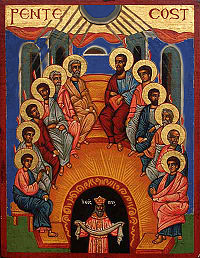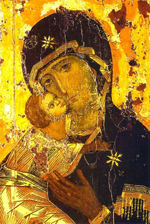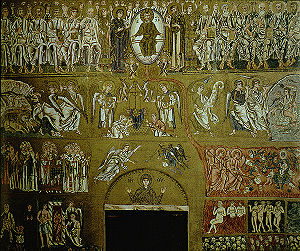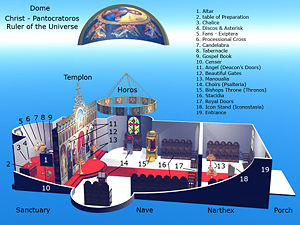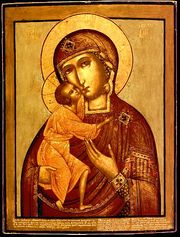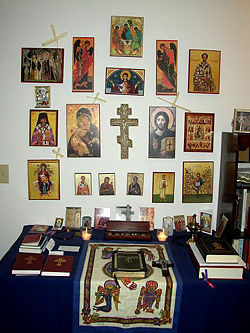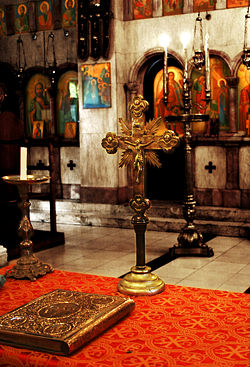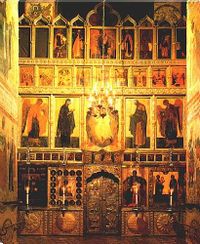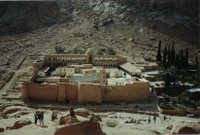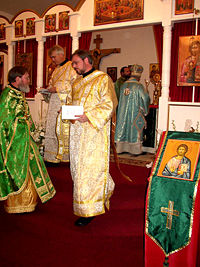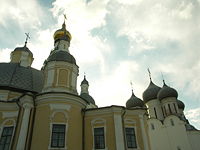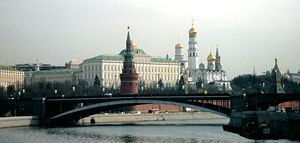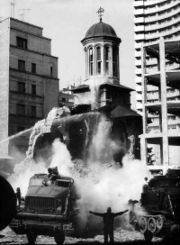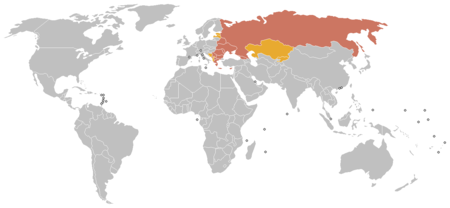Eastern Orthodox Church
2008/9 Schools Wikipedia Selection. Related subjects: Religious movements, traditions and organizations
The Eastern Orthodox Church is the second largest single Christian communion in the world. It is considered by its adherents to be the very same Church established by Christ and his Apostles. It is composed of numerous theologically unified autocephalous ecclesial bodies, each shepherded by a synod of independent bishops whose duty is to preserve the beliefs and practices (Traditions) of the Church. All Orthodox bishops can trace their lineage back to one of the twelve Apostles through the process of apostolic succession.
Eastern Orthodox Christians believe that the Orthodox Church is:
- The authentic and original Christian Church established by Jesus Christ and his Apostles.
- The preserver of the teachings and traditions given to the Early Christians by the Apostles nearly 2000 years ago; and the developer of conciliar interpretations which expand and illuminate the original teachings.
- The preserver of Truth which compares all newer theological ideas to the already established beliefs and practices of the Church; accepting ideas that clarify and correctly teach, while rejecting ideas that are theologically incompatible with the original teachings.
- The preserver and compiler of the New Testament whose texts were written to members of the Church in ancient times and expressed an already established doctrine.
A Note on Nomenclature
Members of the Eastern Orthodox Church usually refer to themselves as simply Orthodox. Eastern is a term often applied in the Western World for the sake of clarity. Members of the Orthodox Church consider themselves to be members of the One Holy Catholic and Apostolic Church, as do members of the Roman Catholic Church, the Anglican Communion, the Assyrian Church, the Coptic Church, and others. As the Orthodox see it the Assyrians and Copts broke from the church after the first few centuries and the Roman Catholics in 1054. Since then the Eastern Church has referred to itself as Orthodox (literally: "Correct Believing"). National pride, local provincialism or frequent use in literature and media outside the Orthodox cultures has led to the addition of national epithets such as "Greek Orthodox", "Russian Orthodox", "Serbian Orthodox", etc. Despite occasional misinformed references to "Russian Orthodox" and "Greek Orthodox" as separate denominations, there are no more differences between these than between terms like "Irish Catholic" or "Italian Catholic". Theologically and spiritually its members believe to be part of only One Church, the Orthodox Church.
Several other ancient Churches in Eastern Europe, Western Asia, and North Africa also use the term Orthodox, but are distinct from the Eastern Orthodox Church as described in this article.
Organization and leadership
The Orthodox Church considers Jesus Christ to be the head of the Church and the Church to be His body. Thus, despite widely held popular belief outside the Orthodox cultures, there is no one bishop at the head of the Orthodox Church; references to the Archbishop, or "Patriarch" of Constantinople (essentially an honorary title) as a leader equivalent or comparable to a Pope in the Catholic Church is mistaken. It is believed that authority and the Grace of God is directly passed down to Orthodox bishops and clergy through the laying on of hands—a practice started by the apostles, and that this unbroken historical and physical link is an essential element of the true church (Acts 8:17, 1 Tim 4:14, Heb 6:2). Each bishop has a territory ( see) over which he governs. His main duty is to make sure the traditions and practices of the Church remain inviolate. Bishops are equal in authority and cannot interfere in each others' territory. Administratively, these bishops and their territories are organized into various autocephalous groups or synods of bishops who gather together at least twice a year to discuss the state of affairs within their respective sees. While bishops and their autocephalous synods have the ability to administer guidance in individual cases, their actions do not usually set precedents that affect the entire church. There have been, however, a number of times when heretical ideas arose to challenge the Orthodox faith and it was necessary to convene a general or "Great" council of all available bishops. The Church considers the first seven ecumenical councils (held between the 4th and the 8th century) to be the most important; however, there have been more, specifically the Synods of Constantinople, 879– 880, 1341, 1347, 1351, 1583, 1819, and 1872, the Synod of Iaşi (Jassy), 1642, and the Pan-Orthodox Synod of Jerusalem, 1672, all of which helped to define the Orthodox position. These councils did not create the doctrines of the church but rather compared the new ideas to the traditional beliefs of the Church. Ideas that were not supported by the traditions of the church were deemed heresy and expunged from the church. The ecumenical councils followed a democratic form with each bishop having one vote. Though present and allowed to speak before the council, members of the Imperial Roman/Byzantine court, abbots, priests, monks and laymen were not allowed to vote. The bishop of the old Roman capital, the Pope of Rome, though not present at all of the councils, was considered to be president of the council and thus called “First Among Equals” until the great schism of 1054. One of the decisions made by the second council and supported by later councils was that the Patriarch of Constantinople, since Constantinople was the " New Rome", should be given the honor of second in rank. Later, because of the split with Rome, the honour of presiding over these general councils was transferred to the Ecumenical Patriarch of Constantinople who was also given the title, "First Among Equals", reflecting both his administrative leadership and his spiritual equality. He is not, however, considered to be the head or leader of the church and several other bishops of important cities of Eastern Christianity have also been granted the honorary title of Patriarch, i.e. Alexandria, Antioch (for the Arab world east of Jerusalem), Jerusalem, Moscow, Peć (for all of Serbia), Bucharest. The Patriarch of Tbilissi (Georgia) is also called a "Catholicos".
Number of adherents
Based on the numbers of adherents, Eastern Orthodoxy is the second largest Christian communion in the world after the Roman Catholic Church. The most common estimates of the number of Eastern Orthodox Christians worldwide is approximately 225-300 million individuals. Orthodoxy is the largest single religious faith in Belarus (88%), Bulgaria (83%), Republic of Macedonia (80%), Republic of Cyprus (80%), Georgia (89%), Greece (98%), Moldova (98%), Montenegro (84%), Romania (87%), Russia (80%), Serbia (84%), and Ukraine (80%). The number of Eastern Orthodox adherents represents about 39% of the population in Bosnia and Herzegovina. As the dominant religion in northern Kazakhstan, it represents 44% of the Kazakhstan, and 4% of Lithuania, 9% of Latvia, and 13% of the Estonian population. Large Christian Orthodox communities exist in the middle eastern countries of Israel/ Palestine (including the West Bank and Gaza), Lebanon, Syria and Jordan (some families can trace their ancestry to the earliest Christians of the Holy Land). In addition, there are also significant Orthodox communities in Western Europe (solely the transplanted Romanian, Serbian, Albanian, Greek and Armenian communities), Africa, Asia, Australia, North America, and South America through the pattern of immigration from Eastern Europe and the Middle East in the last 400 or some years.
Beliefs
Trinity
Orthodox Christians believe in a God who is both three and one (triune). The Father is the cause or origin of the Godhead, from whom the Son is begotten eternally and also from whom the Holy Spirit proceeds eternally. The Holy Trinity is three, distinct, divine persons ( hypostases), without overlap or modality among them, who share one divine essence (ousia)—uncreated, immaterial and eternal. Orthodox doctrine regarding the Holy Trinity is summarized in the Symbol of Faith.
In discussing God's relationship to his creation, Orthodoxy used the concept of a distinction between God's eternal essence which is totally transcendent and his uncreated energies which is how he reaches us. It is also necessary to understand that this is an artificial distinction, not a real one. The God who is transcendent and the God who touches us are one and the same..
Sin, salvation and the incarnation
Human nature, before the fall of man, was pure and innocent. When Adam and Eve disobeyed God in the Garden of Eden, they introduced a new element into human nature (i.e. sin and corruption). This new state prevented man from participation in the Kingdom of Heaven. When God became incarnate on Earth, he changed human nature by uniting the human and the Divine; for this Christ is often called "The New Adam." By his participation in human life, death, and resurrection he sanctified the means whereby we could be restored to our original purity and regain our right relationship with the Father. This is what the Orthodox call salvation from consequences of the sickness of sin. Christ’s salvific act worked retroactively back to the beginning of time thus saving all the righteous people from the bonds of sin, including Adam and Eve.
Resurrection
The Resurrection of Christ is the central event in the liturgical year of the Orthodox Church and is understood in literal terms as a real historical event. Jesus Christ, the Son of God, was crucified and died, descended into Hell (Hades in Greek), rescued all the souls held there through sin; and then, because Hell could not restrain the infinite God, rose from the dead, thus saving all mankind. Through these events, he released mankind from the bonds of Hell and then came back to the living as man and God. That each individual human may partake of this immortality, which would have been impossible without the Resurrection, is the main promise held out by God in his New Testament with mankind, according to Orthodox Christian tradition.
Every holy day of the Orthodox liturgical year relates to the Resurrection directly or indirectly. Every Sunday of the year is dedicated to celebrating the Resurrection and the triune. In the liturgical commemorations of the Passion of Christ during Holy Week there are frequent allusions to the ultimate victory at its completion.
Bible, holy tradition, and the patristic consensus
The Orthodox Church considers itself to be the historical and organic continuation of the original Church founded by Christ and His apostles. The faith taught by Jesus to the apostles, given life by the Holy Spirit at Pentecost, and passed down to future generations uncorrupted, is known as Holy Tradition. The primary and authoritative witness to Holy Tradition is the Bible, texts written or approved by the apostles to record revealed truth and the early history of the Church. Because of the Bible's inspired origin, it is regarded as central to the life of the Church.
The Bible is always interpreted within the context of Holy Tradition, which gave birth to it and canonized it. Orthodox Christians maintain that belief in a doctrine of sola scriptura would be to take the Bible out of the world in which it arose. Orthodox Christians therefore believe that the only way to understand the Bible correctly is within the Orthodox Church.
Other witnesses to Holy Tradition include the liturgy of the Church, its iconography, the rulings of the Ecumenical councils, and the writings of the Church Fathers. From the consensus of the Fathers (consensus patrum) one may enter more deeply and understand more fully the Church's life. Individual Fathers are not looked upon as infallible, but rather the whole consensus of them together will give one a proper understanding of the Bible and Christian doctrine.
Growth vs. Change
From the moment Christ was baptized and he began to gather his apostles the “Church” began to grow. There were numerous followers who attached themselves to the Christ and his mission here on Earth. Sometime after Pentecost the Church grew to a point where it was no longer possible for the Apostles alone to minister to her. The Apostles appointed overseers (Bishops) and assistants (Deacons and Deaconesses) to further the administration of the Church. Later still the territories of these Bishops grew too large for them to administer alone and so they created Presbyters who could function in their place as long as they held to the policies created by the Church through the bishops. As the Church grew so did the complexity of this administration. Patriarchs, Metropolitans, Archimandrites, Abbots and Abbesses, all rose up to cover certain points of administration. Synods and Councils were formed to make decisions and to firmly promote the teachings of the Church. Saints arose to clarify and expand the teachings of the Church. God revealed truth through the workings of the Church through time. Heresies arose to challenge the Church and were exposed for what they were by comparing them to the Truths sustained by the traditions of the Church. All of this is seen by the Orthodox to represent Growth, but not Change. The Church has never changed from its original state. Truth has been revealed and more complexity has been realized, but change has never occurred.
The Theotokos and the Saints
The Eastern Orthodox Church believes death and the separation of body and soul to be unnatural; a result of man’s fall. They also feel that the congregation of the Church comprises both the living and the dead. All persons currently in heaven are considered to be Saints, whether their names are known or not. There are, however, those saints of distinction whom God has revealed to us as particularly good examples for us to learn from either their teachings or their lives. When a Saint is revealed and ultimately recognized by a large portion of the Church a service of official recognition ( glorification) is celebrated for the saint. This does not “make” the person a saint, it merely recognizes him and announces it to the rest of the Church. A day is prescribed for the saint’s celebration, hymns are composed, and icons are created. Numerous saints are celebrated on each day of the year. They are venerated (shown great respect and love) but not worshiped, for worship is due to God alone. In showing the saints this love and requesting their prayers, it is believed by the Orthodox that they thus assist in the process of salvation for others.
Preeminent among the saints is the Virgin Mary, the Theotokos ("birthgiver of God"). The Theotokos was chosen by God and freely cooperated in that choice to be the mother of Jesus Christ, the God-man. The Orthodox believe that the Christ Child from the moment of conception was both fully God and fully Man. She is thus called Theotokos as an affirmation of the divinity of the one to whom she gave birth. It is also believed that her virginity was not compromised in giving birth to God incarnate, that she was not harmed, that she felt no pain, and that she remained forever a virgin. Because of her unique place in salvation history, she is honored above all other saints and especially venerated for the great work that God accomplished through her.
Because of the holiness of the lives of the saints, their bodies and physical items connected with them are regarded by the Church as also holy. Many miracles have been reported throughout history connected with the saints' relics, often including healing from disease and injury. The veneration and miraculous nature of relics continues from Biblical times.
Eschatology
Orthodox Christians believe that when a person dies his soul is “temporarily” separated from his body. Though it may linger for a short period on Earth, it is ultimately escorted either to paradise (Abraham's bosom) or the darkness of Hades, following the Temporary Judgment (Orthodox do not use the term Purgatory). The soul’s experience of either of these states is only a “foretaste,” being experienced only by the soul, until the Final Judgment, when the soul and body will be reunited. The Orthodox believe that the state of the soul in Hades can be affected by the love and prayers of the righteous up until the Last Judgment. For this reason the church offers special prayer for the dead on the third day, ninth day, fortieth day, and the one-year anniversary after the death of an Orthodox Christian. There are also several days throughout the year that are set aside for general commemoration of the departed. These days usually fall on a Saturday, since it was on a Saturday that Christ lay in the Tomb.
While the Orthodox consider the text of the Apocalypse (Book of Revelation) to be a part of scripture, it is also regarded by them to be a mystery. Speculation on the contents of this text are minimal and it is never read in church as part of the regular order of services. Those theologians who have delved into its pages tend to be amillenniaist in their eschatology, believing that the "thousand years" spoken of in biblical prophecy refers to the present time (from the Crucifixion of Christ until the Second Coming). And while it is not usually taught in church it is often used as a reminder of God’s promise to those who love him, and the benefits of avoiding sinful passions. Iconographic depictions of the final judgment are often portrayed on the back wall of the church to remind the faithful as they leave to be vigilant in their struggle against sin. Likewise it is often painted on the walls of the Trapeza (refectory, the room in a monastery where the monastics eat their meals) to inspire sobriety and dis-attachment from worldly things.
The Orthodox believe that after the Final Judgment:
- all souls will be reunited with their resurrected bodies
- that all souls will fully experience their spiritual state
- that having been perfected, mankind will forever progress towards a deeper and fuller love of God, which equates with eternal happiness
- that hell, though often described in metaphor as punishment, is not so much inflicted by God as the soul's inability to participate in God's infinite love which is given freely and abundantly to everyone.
Traditions
Art and architecture
Church buildings
The church building has many symbolic meanings; perhaps the oldest and most prominent is the concept that the Church is the Ark (as in Noah's) in which the world is saved from the flood of temptations. Because of this, most Orthodox Churches are rectangular in design. Another popular shape, especially for churches with large choirs is cruciform or cross-shaped. Architectural patterns may vary in shape and complexity, with chapels sometimes added around the main church, or triple altars (Liturgy may only be performed once a day on any particular altar), but in general, the symbolic layout of the church remains the same.
The origin of the layout of each Orthodox church is based on Solomon's Temple with the Holy of Holies being separated by the iconostasis or templon.
The Church building is divided into three main parts: the narthex ( vestibule), the nave and the sanctuary (also called the altar or holy place). The narthex is where catechumens and non-Orthodox visitors were traditionally asked to stand during services. It is separated from the nave by “The Royal Gate”. On either side of this gate are candle stands (Menalia) representing the pillars of fire that went before the Hebrew people escaping from Egypt. The nave is where most of the congregation stand during services. Traditionally, men stand on the right and women on the left (This is for a number of reasons, when one considers the family unit the husband dominates the relationship. So, in order to emphasize our relationship is with God and not each other, the family unit is broken up. Men and women stand equally before God, equal distance from the altar, male dominance is de-emphasized). In general, men and women dress modestly with little jewelry or make-up. Women cover their heads as prescribed by St. Paul. Children are considered full members of the Church and stand attentive and quiet during services. There may be a choir area on either side or in a loft in back. There is usually a dome in the ceiling with an icon of Christ depicted as Ruler of the Universe (Pantocrator). At the eastern end of the church is a raised dais with an icon covered screen or wall ( iconostasis or templon) separating the nave from the sanctuary. In the center of this wall is the “Beautiful Gate” through which only the clergy may pass. There are access doors on either side usually with icons of the Archangels on them. In the centre of the sanctuary is the Altar. Orthodox priests, when standing at the altar face away from the congregation (They face East). The sanctuary contains all the necessary implements for conducting the various services.
Icons
The term Icon comes from the Greek word eikona, which simply means image. The Orthodox believe that the first icons of Christ and the Virgin Mary were painted by Luke the Evangelist. Icons are filled with symbolism designed to convey information about the person or event depicted. For this reason, icons tend to be formulaic, following a prescribed methodology for how a particular person should be depicted, including hair style, body position, clothing worn, and background details. Icon painting, in general, is not an opportunity for artistic expression, though each iconographer brings his own vision to the piece. It is far more common for an icon to be copied from an older model, though with the recognition of a new saint in the church, a new icon must be created and approved. The personal, idiosyncratic and creative traditions of Western European religious art are largely lacking in Orthodox iconography before the 17th century, when Russian iconography was strongly influenced by religious paintings and engravings from both Protestant and Catholic Europe. Greek iconography also began to take on a strong romantic western influence for a period and the difference between some Orthodox icons and western religious art began to vanish. More recently there has been a strong trend of returning to the more traditional and symbolic representations.
Free-standing statues (three dimensional depictions) are almost non-existent within the Orthodox Church. This is partly due to the rejection of the previous pagan Greek age of idol worship and partly because icons are meant to show the spiritual nature of man, not the sensual earthly body. Bas reliefs, however, became common during the Byzantine period and lead to a tradition of covering a painted icon in a silver or gold “Riza” in order to preserve the icon. Such bas relief coverings usually leave the faces and hands of the saints exposed for veneration.
Icons are not considered by the Orthodox to be idols or objects of worship. The parameters of their usage was clearly spelled out by the 7th ecumenical council. Justification for their usage utilizes the following logic: Before Christ, God took human form no material depiction was possible and therefore blasphemous even to contemplate. Once Christ became human, he was able to be depicted. And because he is God, it is justified to hold in one's mind the image of God Incarnate. Likewise, when one venerates an icon, it is not the wood or paint that are venerated but rather the individual shown, just as it is not the paper one loves when one might kiss the photograph of a loved one. As Saint Basil famously proclaimed, honour or veneration of the icon always passes to its archetype. Following this reasoning through, the veneration of the glorified human saint made in God's image, is always a veneration of the divine image, and hence God as foundational archetype.
Icons can be found adorning the walls of churches and often cover the inside structure completely. Most Orthodox homes have an area set aside for family prayer, usually an eastern facing wall, where are hung many icons.
Icons are often illuminated with a candle or oil lamp. (Beeswax for candles and olive oil for lamps are preferred because they are natural and burn cleanly.) Besides the practical purpose of making icons visible in an otherwise dark church, both candles and oil lamps symbolize the Light of the World which is Christ.
Tales of miraculous icons that moved, spoke, cried, bled, or gushed fragrant myrrh are not uncommon, though it has always been considered that the message of such an event was for the immediate faithful involved and therefore does not usually attract crowds. Some miraculous icons whose reputations span long periods of time nevertheless become objects of pilgrimage along with the places where they are kept. As several Orthodox theologians and saints have explored in the past, the icons' miraculous nature is found not in the material, but in the glory of the saint who is depicted in the icon. The icon is a window, in the words of St Paul Florensky, that actually participates in the glory of what it represents. This is why several icons are believed to bleed myrrh, which is a physical manifestation of the uncreated holy spirit.
See also Eastern Orthodox icons.
Iconostasis
An iconostasis, also called the templon, is a wall of icons and religious paintings, separating the nave from the sanctuary in a church. Iconostasis also refers to a portable icon stand that can be placed anywhere within a church. The modern iconostasis evolved from the Byzantine templon in the eleventh century. The evolution of the iconostasis probably owes a great deal to 14th-century Hesychast mysticism and the wood-carving genius of the Russian Orthodox Church. The first ceiling-high, five-leveled Russian iconostasis was designed by Andrey Rublyov in the cathedral of the Dormition in Vladimir in 1408.
The Cross
Depictions of the Cross within the Orthodox Church are numerous and often highly ornamented. Some carry special significance. The Tri-Bar Cross, as seen to the right, has three bars instead of the single bar normally attached.
The small top crossbar represents the sign that Pontius Pilate nailed above Christ's head. It often is inscribed with an acronym meaning “Jesus of Nazareth, King of the Jews”; however, It is often replaced or amplified by the phrase "The King of Glory" in order to answer Pilate's mocking statement with Christ's affirmation, "My Kingdom is not of this world".
There is also a bottom slanting bar. This appears for a number of reasons. Evidence indicates that there was a small wooden platform for the crucified to stand on in order to support his weight; in Jesus' case his feet were nailed side by side to this platform with one nail each in order to prolong the torture of the cross.
Evidence for this comes mainly from two sources within Holy Tradition, the Bible (in order to cause the victim to die faster their legs were broken so they could not support their weight and would suffocate) and iconography (all early depictions of the crucifixion show this arrangement, not the later with feet on top with single nail). It has also been pointed out by some experts that the nailed hands of a body crucified in the manner often shown in modern secular art would not support the weight of the body and would tear through. A platform for the feet would relieve this problem.
The bottom bar is slanted for two reasons, to represent the very real agony which Christ experienced on the cross (a refutation of Docetism) and to signify that the thief on Christ's right chose the right path while the thief on the left did not. Other crosses associated with the Orthodox church are the more traditional single-bar crosses, budded designs, the Jerusalem cross (cross pattée), Celtic crosses, and others.
Services
The services of the church are properly conducted each day following a rigid, but constantly changing annual schedule (i.e., parts of the service remain the same while others change depending on the day of the year). Services are conducted in the church and involve both the clergy and faithful. Services cannot properly be conducted by a single person, but must have at least one other person present (i.e. a Priest cannot celebrate alone, but must have at least a Chanter present and participating). Usually, all of the services are conducted on a daily basis only in monasteries and cathedrals, while parish churches might only do the services on the weekend and major feast days. On certain Great Feasts (and, according to some traditions, every Sunday) a special All-Night Vigil (Agrypnia) will be celebrated from late at night on the eve of the feast until early the next morning. Because of its festal nature it is usually followed by a breakfast feast shared together by the congregation.
Services, especially the Divine Liturgy, can only be performed once a day on a single altar (some churches have multiple altars in order to accommodate large congregations). Each priest may only celebrate the Divine Liturgy once a day. From its Jewish roots, the liturgical day begins at sundown. The traditional daily cycle of services is as follows:
- Vespers – (Greek Hesperinos) Sundown, the beginning of the liturgical day.
- Compline (Greek Apodeipnon, lit. "After-supper") – After the evening meal prior to bedtime.
- ( Midnight Office – Usually served only in monasteries.)
- Matins (Greek Orthros) – First service of the morning. Usually starts before sunrise.
- Divine Liturgy – The Eucharist service (see below)
- Hours – First, Third, Sixth, and Ninth – Sung either at their appropriate times, or in aggregate at other customary times of convenience. If the latter, The First Hour is sung immediately following Orthros, the Third and Sixth prior to the Divine Liturgy, and the Ninth prior to Vespers.
The Divine Liturgy is the celebration of the Eucharist. Although it is usually celebrated between the Sixth and Ninth Hours, it is not considered to be part of the daily cycle of services, as it occurs outside the normal time of the world. The Divine Liturgy is not celebrated on weekdays during the preparatory season of Great Lent and in some places during the lesser fasting seasons either. Reserve communion is prepared on Sundays and is distributed during the week at the Liturgy of the Presanctified Gifts.
This daily cycle services are conceived of as both the sanctification of time ( chronos, the specific times during which they are celebrated), and entry into eternity ( kairos). They consist to a large degree of litanies asking for God's mercy on the living and the dead, readings from the Psalter with introductory prayers, troparia, and other prayers and hymns surrounding them. The Psalms are so arranged that when all the services are celebrated the entire Psalter is read through in their course once a week, and twice a week during Great Lent when the services are celebrated in an extended form.
Chanting
Orthodox services are sung nearly in their entirety. Services consist in part of a dialog between the clergy and the people (often represented by the choir or the Psaltis (Cantor). In each case the prayers are sung or chanted following a prescribed musical form. Almost nothing is read in a normal speaking voice, with the exception of the homily if one is given. Because the human voice is the most perfect instrument of praise and because inanimate objects do not pray, musical instruments (organs, guitars, etc.) are not generally used to accompany the choir (except where traditions have been lost to a heavy western influence). The church has developed eight Modes or Tones, (see Octoechos) within which a chant may be set, depending on the time of year, feast days, or other considerations of the Typikon. There are numerous versions and styles that are traditional and acceptable and these vary a great deal between cultures. It is common, especially in the United States, for a choir to learn many different styles and to mix them, singing one response in Greek, then English, then Russian, etc. It should also be noted that in the Russian tradition there have been some very famous composers of Church music such as Tchaikovsky and Rachmaninoff; and many Church tones can likewise be seen influencing their music.
Incense
As part of the legacy handed down from its Judaic roots, incense is used during all services in the Eastern Orthodox Church as an offering of worship to God as it was done in the Jewish First and Second Temples in Jerusalem (Exodus chapter 30). Traditionally, the base of the incense used is the resin of Boswellia thurifera, also known as frankincense, but the resin of fir trees has been used as well. It is usually mixed with various floral essential oils giving it a sweet smell. Incense represents the sweetness of the prayers of the saints rising up to God ( Psalm 141:2, Revelation 5:8, 8:4). The incense is burned in an ornate golden censer that hangs at the end of three chains representing the Trinity. In the Greek tradition there are 12 bells hung along these chains representing the 12 apostles (usually no bells in Slavic tradition). The censer is used (swung back and forth) by the priest/deacon to venerate all four sides of the altar, the holy gifts, the clergy, the icons, the congregation, and the church structure itself.
Mysteries
According to Orthodox theology, the purpose of the Christian life is to attain theosis, the mystical union of man with God. This union is understood as both collective and individual. St. Athanasius of Alexandria, wrote concerning the Incarnation that, "He (Jesus) was made man that we might be made god (θεοποιηθῶμεν)". See 2 Peter 1:4, John 10:34–36, Psalm 82:6. The entire life of the church is oriented towards making this possible and facilitating it.
In the Orthodox Church the terms “Mystery” or “The Mysteries” refer to the process of theosis. While it is understood that God theoretically can do anything instantly and invisibly, it is also understood that he generally chooses to use material substance as a medium in order to reach people. The limitations are those of mankind, not God. Matter is not considered to be evil by the Orthodox. Water, oil, bread, wine, etc., all are means by which God reaches out to allow people to draw closer to him. How this process works is a “Mystery”, and cannot be defined in human terms. These Mysteries are surrounded by prayer and symbolism so that their true meaning will not be forgotten.
Those things which in the West are often termed Sacraments or sacramentals are known among the Orthodox as the Sacred Mysteries. While the Roman Catholic Church numbers seven Sacraments, and many Protestant groups list two (Baptism and the Eucharist) or even none, the Orthodox do not limit the number. However, for the sake of convenience, catechisms will often speak of the seven Great Mysteries. Among these are Holy Communion (the most direct connection), Baptism, Chrismation, Confession, Unction, Matrimony, and Ordination. But the term also properly applies to other sacred actions such as monastic Tonsure or the blessing of holy water, and involves fasting, almsgiving, or an act as simple as lighting a candle, burning incense, praying or asking God's blessing on food.
Baptism
Baptism is the mystery which transforms the old sinful man into the new, pure man; the old life, the sins, any mistakes made are gone and a clean slate is given. Through baptism one is united to the Body of Christ by becoming a member of the Orthodox Church. During the service water is blessed. The catechumen is fully immersed in the water three times in the name of the Holy Trinity. This is considered to be a death of the "old man" by participation in the crucifixion and burial of Christ, and a rebirth into new life in Christ by participation in his resurrection. Properly a new name is given, which becomes the person's name.
Children of Orthodox families are normally baptized shortly after birth. Converts to Orthodoxy (even converts from other Christian denominations) are usually formally baptized into the Orthodox Church though exceptions are sometimes made. Those who have left Orthodoxy and adopted a new religion, if they return to their Orthodox roots are usually received back into the church through the mystery of Chrismation.
Properly, the mystery of baptism is administered by bishops and priests; however, in emergencies any Orthodox Christian can baptize. In such cases, should the person survive the emergency, it is likely that the person will be properly baptized by a priest at some later date. This is not considered to be a second baptism, nor is it imagined that the person is not already Orthodox, but rather it is a fulfillment of the proper form.
The service of baptism used in Orthodox churches has remained largely unchanged for over 1500 years. This fact is witnessed to by St. Cyril of Jerusalem (d. 386), who, in his Discourse on the Sacrament of Baptism, describes the service in much the same way as is currently in use.
Chrismation
Chrismation (sometimes called confirmation) is the mystery by which a baptized person is granted the gift of the Holy Spirit through anointing with Holy Chrism. It is normally given immediately after baptism as part of the same service, but is also used to receive lapsed members of the Orthodox Church. As baptism is a person's participation in the death and resurrection of Christ, so Chrismation is a person's participation in the coming of the Holy Spirit at Pentecost.
A baptized and Chrismated Orthodox Christian is a full member of the Church, and may receive the Eucharist regardless of age.
The creation of Chrism may be accomplished by any bishop at any time, but usually is done only once a year, often when a synod of bishops convenes for its annual meeting. (Some autocephalous churches get their chrism from others.) Anointing with it substitutes for the laying-on of hands described in the New Testament, even when an instrument such as a brush is used.
Fasting
The number of fast days varies from year to year, but in general the Orthodox Christian can expect to spend a little over half the year fasting at some level of strictness. There are spiritual, symbolic, and even practical reasons for fasting. In the Fall from Paradise mankind became possessed by a carnal nature; that is to say, he became inclined towards the passions. Through fasting, Orthodox Christians attempt to return to the relationship of love and obedience to God enjoyed by Adam and Eve in Paradise in their own lives, by refraining from carnal practices, by bridling the tongue ( James 3:5–6), confession of sins, prayer and almsgiving.
Fasting is seen as purification and the regaining of innocence. Through obedience to the Church and its ascetic practices the Orthodox Christian seeks to rid himself or herself of the passions (The desires of our fallen carnal nature). All Orthodox Christians are expected to fast following a prescribed set of guidelines. They do not view fasting as a hardship, but rather as a privilege and joy. The teaching of the Church fixes both the times and the amount of fasting that is expected as a minimum for every member. For greater ascesis, some may choose to go without food entirely for a short period of time. A complete three-day fast at the beginning and end of a fasting period is not unusual, and some fast for even longer periods, though this is usually practiced only in monasteries.
In general, fasting means abstaining from meat and meat products, dairy (eggs and cheese) and dairy products, fish, olive oil, and wine. Wine and oil — and, less frequently, fish — are allowed on certain feast days when they happen to fall on a day of fasting; but animal products and dairy are forbidden on fast days, with the exception of "Cheese Fare" week which precedes Great Lent, during which dairy products are allowed. Wine and oil are usually also allowed on Saturdays and Sundays during periods of fast. In some Orthodox traditions, caviar is permitted on Lazarus Saturday, the Saturday before Palm Sunday, although the day is otherwise a fast day. Married couples also abstain from sexual relations on fast days, that they may devote themselves to prayer ( I Corinthians 7:5).
While it may seem that fasting in the manner set forth by the Church is a strict rule, there are circumstances where a person's spiritual guide may allow a dispensation because of some physical necessity (e.g. those who are pregnant or infirm, the very young and the elderly, or those who have no control over their diet, such as prisoners or soldiers).
The time and type of fast is generally uniform for all Orthodox Christians; the times of fasting are part of the ecclesiastical calendar, and the method of fasting is set by the Holy Canons and Sacred Tradition. There are four major fasting periods during the year:
- The Nativity Fast (Advent or "Winter Lent") which is the 40 days preceding the Nativity of Christ (Christmas), beginning on November 15 and running through December 24. This fast becomes more severe after December 20, and Christmas Eve is observed a strict fast day.
- Great Lent which consists of the 6 weeks (40 Days) preceding Palm Sunday, and Great Week (Holy Week) which precedes Pascha (Easter).
- The Apostles' Fast which varies in length from 8 days to 6 weeks. It begins on the Monday following All Saints Sunday (the first Sunday after Pentecost) and extends to the Feast of Saints Peter and Paul on June 29. Since the date of Pentecost depends on that of Pascha, and Pascha is determined on the Julian Calendar, this fast can disappear completely under New Calendar observance (This is one of the objections raised by opponents to the New Calendar).
- The Dormition Fast, a two-week long Fast preceding the Dormition of the Theotokos (repose of The Virgin Mary), lasting from August 1 through August 14.
In addition to these fasting seasons, Orthodox Christians fast on every Wednesday (in commemoration of Christ's betrayal by Judas Iscariot) and Friday (in commemoration of his Crucifixion) throughout the year. Monastics often fast on Mondays (in imitation of the Angels, who are commemorated on that day in the weekly cycle, since monastics are striving to lead an angelic life on earth, and angels neither eat nor drink).
Orthodox Christians who are preparing to receive the Eucharist do not eat or drink at all from midnight until after taking Holy Communion. A similar total fast is expected to be kept on the Eve of Nativity, the Eve of Theophany (Epiphany), Great Friday and Holy Saturday for those who can do so. There are other individual days observed as fasts (though not as days of total fasting) no matter what day of the week they fall on, such as the Beheading of St. John the Baptist on August 29 and the Exaltation of the Holy Cross on September 14.
Strict fasting is canonically forbidden on Saturdays and Sundays due to the festal character of the Sabbath and the Resurrection, respectively. On those days wine and oil are permitted even if abstention from them would be otherwise called for. Holy Saturday is the only Saturday of the year where a strict fast is kept.
There are also four periods in the liturgical year during which no fasting is permitted, even on Wednesday and Friday. These fast-free periods are:
- The week following Pascha (Easter), also known as Bright Week
- The week following Pentecost
- The period from the Nativity of Christ up to (but not including) the Eve of Theophany (Epiphany). The day of Theophany itself is always fast-free, even if it falls on a Wednesday or Friday.
- The week following the Sunday of the Publican and the Pharisee (one of the preparatory Sundays before Great Lent). This is fast-free to remind the faithful not to boast like the Pharisee that he fasts for two days out of the week Luke 18:12).

When certain feast days fall on fast days, the fasting laws are lessened to a certain extent, to allow some consolation in the trapeza (refectory) for the longer services, and to provide an element of sober celebration to accompany the spiritual joy of the feast.
It is considered a greater sin to advertise one's fasting than to not participate in the fast. Fasting is a purely personal communication between the Orthodox Christian and God. If one has health concerns, or responsibilities that cannot be fulfilled because of fasting, then it is perfectly permissible not to fast. An individual's observance of the fasting laws is not to be judged by the community ( Romans 14:1–4), but is a private matter between him and his Spiritual Father or Confessor.
Almsgiving
" Almsgiving" refers to any charitable giving of material resources to those in need. Along with prayer and fasting, it is considered a pillar of the personal spiritual practices of the Orthodox Christian tradition. Almsgiving is particularly important during periods of fasting, when the Orthodox believer is expected to share the monetary savings from his or her decreased consumption with those in need. As with fasting, bragging about the amounts given for charity is considered anywhere from extremely rude to sinful.
Holy Communion
The Eucharist is at the centre of Orthodox Christianity. In practice, it is the partaking of the Body and Blood of Jesus Christ in the midst of the Divine Liturgy with the rest of the church. The bread and wine are believed to become the genuine Body and Blood of the Christ Jesus through the operation of the Holy Spirit. The Eastern Orthodox Church has never described exactly how this occurs, or gone into the detail that the Roman Catholic Church has in the West. The doctrine of transubstantiation was formulated after the Great Schism took place, and the Orthodox churches have never formally affirmed or denied it, preferring to state simply that it is a "Mystery". Communion is given only to baptized, Chrismated Orthodox Christians who have prepared by fasting, prayer, and confession. The priest will administer the Gifts with a spoon directly into the recipient's mouth from the chalice. From baptism young infants and children are carried to the chalice to receive Holy Communion.
Repentance
Orthodox Christians who have committed sins but repent of them, and who wish to reconcile themselves to God and renew the purity of their original baptisms, confess their sins to God before a spiritual guide who offers advice and direction to assist the individual in overcoming their sin. Parish priests commonly function as spiritual guides, but such guides can be any person, male or female, who has been given a blessing to hear confessions. Spiritual guides are chosen very carefully as it is a mandate that once chosen, they must be obeyed. Having confessed, the penitent then has his or her parish priest read the prayer of repentance over them.
Sin is not viewed by the Orthodox as a stain on the soul that needs to be wiped out, or a legal transgression that must be set right by a punitive sentence, but rather as a mistake made by the individual with the opportunity for spiritual growth and development. An act of Penance (epitemia), if the spiritual guide requires it, is never formulaic, but rather is directed toward the individual and their particular problem, as a means of establishing a deeper understanding of the mistake made, and how to effect its cure. Though it sounds harsh, temporary excommunication is fairly common (The Orthodox require a fairly high level of purity in order to commune, therefore certain sins make it necessary for the individual to refrain from communing for a period). Confession and repentance are required in order to raise the individual to a level capable of communing (though no one is truly worthy). Because full participatory membership is granted to infants, it is not unusual for even small children to confess; though the scope of their culpability is far less than an older child, still their opportunity for spiritual growth remains the same.
Marriage
Marriage, within the Orthodox Church is seen as an act of God in which He sanctifies the joining of man and woman into one. First and foremost this joining is seen as a dispensation allowed by God for the mutual comfort and support of the individuals involved. While procreation and the perpetuation of the species is seen as important, what is more important is the bond of love between the husband and wife as this is a reflection of our ultimate union with God. Although difficult to accurately measure, the divorce rate in the Orthodox Church seems to be lower than that of the societal averages where its members reside, comprising at least 14% of marriages performed but probably somewhat higher due to civil divorces obtained without an accompanying ecclesiastical divorce. The Church does recognize that there are occasions when it is better that couples do separate. It remains the decision of one's Bishop if they should desire to marry again if they will be permitted to do so. Generally widows may remarry as well as some divorced. A man is not permitted to be a priest if he or his wife have ever been divorced. If a person is undergoing a second marriage because of a divorce the sacrament is different and contains prayers or repentance for the first failed marriage.
The Mystery of Marriage in the Orthodox Church has two distinct parts: The Betrothal and The Crowning. The Betrothal includes: The exchange of the rings, the procession, the declaration of intent, and the lighting of candles. The Crowning includes: The readings from the epistle and gospel, the Blessing of the Common Cup, and the Dance of Isaiah (the bride and groom are led around the table 3 times), and then the Removal of the Crowns. There is no exchange of vows. There is a set expectation of the obligations incumbent on a married couple, and whatever promises they may have privately to each other are their responsibility to keep. The ceremony ends with the reading of Benedictions to and the Greeting of the Couple.
Monasticism
All Orthodox Christians are expected to participate in at least some ascetic works, in response to the commandment of Christ to "come, take up the cross, and follow me." ( Mark 10:21 and elsewhere) They are therefore all called to imitate, in one way or another, Christ himself who denied himself to the extent of literally taking up the cross on the way to his voluntary self-sacrifice. However, laypeople are not expected to live in extreme asceticism since this is close to impossible while undertaking the normal responsibilities of worldly life. Those who wish to do this therefore separate themselves from the world and live as monastics: monks and nuns. As ascetics par excellence, using the allegorical weapons of prayer and fasting in spiritual warfare against their passions, monastics hold a very special and important place in the Church. This kind of life is often seen as incompatible with any kind of worldly activity including that which is normally regarded as virtuous. Social work, school teaching, and other such work is therefore usually left to laypeople.
There are three main types of monastics. Those who live in monasteries under a common rule are coenobitic. Each monastery may formulate its own rule, and although there are no religious orders in Orthodoxy some respected monastic centers such as Mount Athos are highly influential. Eremitic monks, or hermits, are those who live solitary lives. It is the yearning of many who enter the monastic life to eventually become solitary hermits. This most austere life is only granted to the most advanced monastics and only when their superiors feel they are ready for it. Hermits are usually associated with a larger monastery but live in seclusion some distance from the main compound. Their local monastery will see to their physical needs, supplying them with simple foods while disturbing them as little as possible. In between are those in semi-eremitic communities, or sketes, where one or two monks share each of a group of nearby dwellings under their own rules and only gather together in the central chapel, or kyriakon, for liturgical observances.
The spiritual insight gained from their ascetic struggles make monastics preferred for missionary activity. Bishops are almost always chosen from among monks, and those who are not generally receive the monastic tonsure before their consecrations.
Many (but not all) Orthodox seminaries are attached to monasteries, combining academic preparation for ordination with participation in the community's life of prayer. Monks who have been ordained to the priesthood are called hieromonk (priest-monk); monks who have been ordained to the diaconate are called hierodeacon (deacon-monk). Not all monks live in monasteries, some hieromonks serve as priests in parish churches thus practicing "monasticism in the world".
Cultural practices differ slightly but in general, Father is the correct form of address for monks who have been tonsured, while Novices are addressed as Brother. Similarly, Mother is the correct form of address for nuns who have been tonsured, while Novices are addressed as Sister. Nuns live identical ascetic lives to their male counterparts and are therefore also called monachoi (monastics) or the feminine plural form in Greek, monachai, and their common living space is called a monastery.
Holy Orders
Since its founding, the Church spread to different places, and the leaders of the Church in each place came to be known as episkopoi (overseers, plural of episkopos, overseer — Gr. ἐπίσκοπος), which became " bishop" in English. The other ordained roles are presbyter (Gr. πρεσβύτερος, elder), which became "prester" and then " priest" in English, and diakonos (Gr. διάκονος, servant), which became " deacon" in English (see also subdeacon). There are numerous administrative positions in the clergy that carry additional titles. In the Greek tradition, bishops who occupy an ancient See are called Metropolitan, while the lead bishop in Greece is the Archbishop. (In the Russian tradition, however, the usage of the terms "Metropolitan" and "Archbishop" is reversed.) Priests can be archpriests, archimandrites, or protopresbyters. Deacons can be archdeacons or protodeacons, as well. The position of deacon is often occupied for life. The deacon also acts as an assistant to a bishop.
With the exception of Bishops, who remain celibate, the Orthodox Church has always allowed priests and deacons to be married, provided the marriage takes place before ordination. In general it is preferable for parish priests to be married as they often act as council to married couples and thus can draw on their own experience. Unmarried priests usually are monks and live in monasteries, though there are occasions when, because of a lack of married priests, a monk-priest is temporarily assigned to a parish. Widowed priests and deacons may not remarry, and it is common for such a member of the clergy to retire to a monastery (see clerical celibacy). This is also true of widowed wives of clergy, who do not remarry and become nuns when their children are grown. There is serious discussion about reviving the order of ( deaconess), which fell into disuse in the first millennium; the deaconesses had both liturgical and pastoral functions within the church. Although it has fallen out of practice (the last deaconess was ordained in the 19th century) there is no reason why deaconesses could not be ordained today.
Unction
Anointing with oil, or Holy Unction, is one of the many mysteries administered by the Orthodox Church. The Mystery is far more common in the Orthodox Church than it had traditionally been in the Roman Catholic Church (until recent years). In both Churches today it is not reserved for the dying or terminally ill, but for all in need of spiritual or bodily healing. In Greece, during the Ottoman occupation, it became the custom to administer this Mystery annually on Great Wednesday to all believers; in recent decades, this custom has spread to many other locations. It is often distributed on major feast days, or any time the clergy feel it necessary for the spiritual welfare of its congregation.
According to Orthodox teaching Holy Unction is based on the Epistle of James:
Is anyone among you sick? Let him call for the elders of the church, and let them pray over him, anointing him with oil in the name of the Lord. And the prayer of faith will save the sick, and the Lord will raise him up. And if he has committed sins, he will be forgiven. — James 5:14–15
History
Early Church

Christianity spread rapidly throughout the Roman Empire in part because Greek was the lingua franca, and partly because its philosophy of truth was something new and different than the old Roman and Greek social religions. Paul and the Apostles traveled extensively throughout the Empire, including Asia Minor, establishing Churches in major communities, with the first Churches appearing in Jerusalem and the Holy Land, then in Antioch and its surrounding regions, Rome, Alexandria, Athens, Thessalonica, and Byzantium, which, centuries later would become far more prominent as the New Rome. Christianity was met with some resistance as its adherents would not comply with the state (even at the threat of death) in offering sacrifice to the pagan gods. The blood of numerous and often famous martyrs became the mortar binding the structure of the Church together. Despite persecution, or perhaps, because of it, the Church spread and flourished. It was finally released from bondage by the Emperor Constantine the Great in 324 AD.
By the 4th century Christianity had spread far and wide with hundreds of bishops in numerous countries. A number of influential schools of thought had arisen, particularly the Alexandrian and Antiochian philosophical approaches. One smaller group, the Arians, had managed to gain some influence which was causing some theological conflicts within the Church. The Emperor Constantine realized the need for a great ecumenical synod to be held in order to better define the Church's position. He made it possible for this council to meet not only by providing a location, but by offering to pay for the transportation of all the existing bishops of the Church.
Ecumenical councils
Several doctrinal disputes from the 4th century onwards led to the calling of Ecumenical councils.
The canons set forth by nine ecumenical councils are considered by Eastern Orthodox Christianity to be the most significant and binding.
- The First Ecumenical Council was convoked by the Roman Emperor Constantine at Nicaea in 325 and presided over by the Patriarch Alexander of Alexandria, with over 300 bishops condemning the view of Arius that the Son is a created being inferior to the Father.
- The Second Ecumenical Council was held at Constantinople in 381, presided over by the Patriarchs of Alexandria and Antioch, with 150 bishops, defining the nature of the Holy Spirit against those asserting His inequality with the other persons of the Trinity.
- The Third Ecumenical Council is that of Ephesus in 431, presided over by the Patriarch of Alexandria, with 250 bishops, which affirmed that Mary is truly "Birthgiver" or "Mother" of God ( Theotokos), contrary to the teachings of Nestorius.
- The Fourth Ecumenical Council is that of Chalcedon in 451, Patriarch of Constantinople presiding, 500 bishops, affirmed that Jesus is truly God and truly man, without mixture of the two natures, contrary to Monophysite teaching.
- The Fifth Ecumenical Council is the second of Constantinople in 553, interpreting the decrees of Chalcedon and further explaining the relationship of the two natures of Jesus; it also condemned the teachings of Origen on the pre-existence of the soul, etc.
- The Sixth Ecumenical Council is the third of Constantinople in 681; it declared that Christ has two wills of his two natures, human and divine, contrary to the teachings of the Monothelites.
- The Seventh Ecumenical Council was called under the Empress Regent Irene in 787, known as the second of Nicaea. It supports the veneration of icons while forbidding their worship. It is often referred to as "The Triumph of Orthodoxy"
- The Eight Ecumenical Council also known as The Fourth Council of Constantinople was called in 879. It restored St. Photius to his See in Constantinople and condemned any alteration of the Nicene-Constantinopolitan Creed of 381. The council was accepted as ecumenical by all five patriarchs, including Pope John VIII of Rome.
- The Ninth Ecumenical Council also known as The Fifth Council of Constantinople was actually a series of councils held between 1341 and 1351. It affirmed the hesychastic theology of St. Gregory Palamas and condemned the philosopher Barlaam of Calabria.
In addition to these councils there have been a number of significant councils meant to further define the Orthodox position. They are the Synods of Constantinople, 1484, 1583, 1755, 1819, and 1872, the Synod of Iaşi (Jassy), 1642, and the Pan-Orthodox Synod of Jerusalem, 1672.
Roman/Byzantine Empire
Orthodox Christian culture reached its golden age during the high point of Byzantine Empire and continued to flourish in Russia, after the fall of Constantinople. Numerous autocephalous churches were established in Eastern Europe and Slavic areas.
In the 530s the Church of the Holy Wisdom (Hagia Sophia) was built in Constantinople under emperor Justinian I.
Early Schisms
The Church in Egypt ( Patriarchate of Alexandria) split into two groups following the Council of Chalcedon (451), over a dispute about the relation between the divine and human natures of Jesus. Eventually this led to each group anathematizing the other. Those that remained in communion with the other patriarchs (those who accepted the Council of Chalcedon) were called "Melkites" (the king's men, because Constantinople was the city of the emperors) [not to be confused with the Melkite Catholics of Antioch]. Those who disagreed with the findings of the Council of Chalcedon are today known as the Coptic Orthodox Church of Alexandria, currently led by Pope Shenouda III. There was a similar split in Syria ( Patriarchate of Antioch) resulting in the Syriac Orthodox Church.
Those who disagreed with the Council of Chalcedon are sometimes called " Oriental Orthodox" to distinguish them from the Eastern Orthodox, who accepted the Council of Chalcedon. Oriental Orthodox are also sometimes referred to as " monophysites", "non-Chalcedonians", or "anti-Chalcedonians", although today the Oriental Orthodox Church denies that it is monophysite and prefers the term " miaphysite", to denote the "joined" nature of Jesus. Both the Eastern Orthodox and Oriental Orthodox churches formally believe themselves to be the continuation of the true church and the other fallen into heresy, although over the last several decades there has been some reconciliation.
As well, there are the " Nestorian" churches, which are Eastern Christian churches that keep the faith of only the first two ecumenical councils, i.e., the First Council of Nicaea and the First Council of Constantinople. "Nestorian" is an outsider's term for a tradition that predated the influence of Nestorius. Thus, "Persian Church" is a more neutral term.
Conversion of East and South Slavs
In the ninth and tenth centuries, Orthodoxy made great inroads into Eastern Europe, including Kievan Rus'. This work was made possible by the work of the Byzantine saints Cyril and Methodius. When Rastislav, the king of Moravia, asked Byzantium for teachers who could minister to the Moravians in their own language, Byzantine emperor Michael III chose these two brothers. As their mother was a Slav from the hinterlands of Thessaloniki, Cyril and Methodius spoke the local Slavonic vernacular and translated the Bible and many of the prayer books. As the translations prepared by them were copied by speakers of other dialects, the hybrid literary language Old Church Slavonic was created. Originally sent to convert the Slavs of Great Moravia, Cyril and Methodius were forced to compete with Frankish missionaries from the Roman diocese. Their disciples were driven out of Great Moravia in AD 886.
Some of the disciples, namely Saint Clement of Ohrid, Saint Naum who were of noble Bulgarian descent and St. Angelaruis, returned to Bulgaria where they were welcomed by the Bulgarian Tsar Boris I who viewed the Slavonic liturgy as a way to counteract Greek influence in the country. In a short time the disciples of Cyril and Methodius managed to prepare and instruct the future Slav Bulgarian clergy into the Glagolitic alphabet and the biblical texts and in AD 893, Bulgaria expelled its Greek clergy and proclaimed the Slavonic language as the official language of the church and the state. The success of the conversion of the Bulgarians facilitated the conversion of East Slavic peoples, most notably the Rus', predecessors of Belarusians, Russians, and Ukrainians.
The work of the Thessaloniki brothers Cyril and Methodius and their disciples had a major impact to Serbs as well. However, they accepted Orthodoxy collectively by families and by tribes (in the process between the 7th and the 9th century). In commemoration of their baptisms, each Serbian family or tribe began to celebrate an exclusively Serbian custom called Slava in a special way to honour the Saint on whose day they received the sacrament of Holy Baptism. It is the most solemn day of the year for all Serbs of the Orthodox faith and has played a role of vital importance in the history of the Serbian people. Slava is actually the celebration of the spiritual birthday of the Serbian people which the Church blessed and proclaimed it a Church institution.
The missionaries to the East and South Slavs had great success in part because they used the people's native language rather than Latin as the Roman priests did, or Greek. Today the Russian Orthodox Church is the largest of the Orthodox Churches followed by the Romanian Orthodox Church
Great Schism
In the 11th century the Great Schism took place between Rome and Constantinople, which led to separation of the Church of the West, the Roman Catholic Church, and the Eastern Orthodox Church. There were doctrinal issues like the filioque clause and the authority of the Roman Catholic Pope involved in the split, but these were exacerbated by cultural and linguistic differences between Latins and Greeks. Prior to that, the Eastern and Western halves of the Church had frequently been in conflict, particularly during periods of iconoclasm and the Photian schism.
The final breach is often considered to have arisen after the capture and sacking of Constantinople by the Fourth Crusade in 1204. The sacking of the Church of Holy Wisdom and establishment of the Latin Empire as a seeming attempt to supplant the Orthodox Byzantine Empire in 1204 is viewed with some rancour to the present day. In 2004, Pope John Paul II extended a formal apology for the sacking of Constantinople in 1204; the apology was formally accepted by Patriarch Bartholomew of Constantinople. Many things that were stolen during this time— holy relics, riches, and many other items—were not returned and are still held in various Western European cities, particularly Venice.
East and West attempted reunion twice, in 1274 at the Second Council of Lyon, and in 1439 at the Council of Basel. In each case, however, the councils were rejected by the Orthodox people as a whole.
Age of captivity
In 1453, the Byzantine Empire fell to the Ottoman Empire. By this time Egypt had been under Muslim control for some seven centuries, but Orthodoxy was very strong in Russia which had recently acquired an autocephalous status; and thus Moscow called itself the Third Rome, as the cultural heir of Constantinople.
Under Ottoman rule, the Greek Orthodox Church acquired substantial power as an autonomous millet. The ecumenical patriarch was the religious and administrative ruler of the entire "Greek Orthodox nation" (Ottoman administrative unit), which encompassed all the Eastern Orthodox subjects of the Empire.
As a result of the Ottoman conquest of the Byzantine Empire in 1453, and the Fall of Constantinople, the entire Orthodox communion of the Balkans and the Near East became suddenly isolated from the West. For the next four hundred years, it would be confined within Islamic world, with which it had little in common religiously or culturally. The Russian Orthodox Church and the Orthodox Churches from Wallachia and Moldavia were the only part of the Orthodox communion which remained outside the control of the Ottoman Empire. It is, in part, due to this geographical and intellectual confinement that the voice of Eastern Orthodoxy was not heard during the Reformation in sixteenth century Europe. It should not be surprising that this important theological debate often seems strange and distorted to the Orthodox; after all, they never took part in it and thus neither Reformation nor Counter-Reformation is part of their theological framework.
Russian Orthodox Church under Tsarist rule
Up until 1666, when Patriarch Nikon was deposed by the tsar, the Russian Orthodox Church had been independent of the State. In 1721 Tsar Peter I abolished completely the patriarchate and so the Church effectively became a department of the government, ruled by a Most Holy Synod composed of senior bishops and lay bureaucrats appointed by the Tsar himself. Since 1721 until the October Revolution of 1917, the Russian Orthodox Church was essentially transformed into a governmental agency, a tool used to various degrees by the tsars in the imperial campaigns of russification. The Church was allowed by the State to levy taxes off on the peasants. Therefore, the Church, along with the Tsarist State to which it belonged, came to be perceived as an enemy of the people by the Bolsheviks and the other Russian revolutionaries, mostly atheists. The revolution brought, however, a brief period of liberation for the Church: an independent patriarchate was reestablished briefly in 1917, until Stalin quashed the Church a few years later, imprisoning or killing many of the clergy and of the faithful. Part of the clergy escaped the Soviet persecutions by fleeing abroad, where they founded an independent church in exile, reunified with the Russian one in 2007.
Russian Orthodox Church under Communist rule
The Orthodox Church clergy in Russia was seen as sympathetic with the cause of the White Army in the Civil War (see White movement) after the October Revolution, and occasionally collaborated with it; Patriarch Tikhon's declared position was harshly anti-Bolshevik in 1918. This may have further strengthened the Bolshevik animus against the church.
Before and after the October Revolution of November 7, 1917 (October 25 Old Calendar) there was a movement within the Soviet Union to unite all of the people of the world under Communist rule (see Communist International). This included the Eastern European bloc countries as well as the Balkan States. Since some of these Slavic states tied their ethnic heritage to their ethnic churches, both the peoples and their church were targeted by the Soviet.
The Soviets' official interpretation of freedom of conscience was one of "guaranteeing the right to profess any religion, or profess none, to practice religious cults, or conduct atheist propaganda", though in effect atheism was sponsored by state and was taught in all educational establishments. Public criticism of atheism was unofficially forbidden and sometimes led to imprisonment.
The Soviet Union was the first state to have as an ideological objective the elimination of religion. Toward that end, the Communist regime confiscated church property, ridiculed religion, harassed believers, and propagated atheism in the schools. Actions toward particular religions, however, were determined by State interests, and most organized religions were never outlawed. Some actions against Orthodox priests and believers along with execution included torture being sent to prison camps, labour camps or mental hospitals.
The result of this militant atheism was to transform the Church into a persecuted and martyred Church. In the first five years after the Bolshevik revolution, 28 bishops and 1,200 priests were executed.
The main target of the anti-religious campaign in the 1920s and 1930s was the Russian Orthodox Church, which had the largest number of faithful. Nearly all of its clergy, and many of its believers, were shot or sent to labor camps. Theological schools were closed, and church publications were prohibited. In the period between 1917 and 1940, the number of Orthodox Churches in the Russian Republic fell from 59,584 to less than 500. Between 1917 and 1935, 130,000 Orthodox priests were arrested. Of these, 95,000 were put to death, executed by firing squad.
After Nazi Germany's attack on the Soviet Union in 1941, Joseph Stalin revived the Russian Orthodox Church to intensify patriotic support for the war effort. By 1957 about 22,000 Russian Orthodox churches had become active. But in 1959 Nikita Khrushchev initiated his own campaign against the Russian Orthodox Church and forced the closure of about 12,000 churches. By 1985 fewer than 7,000 churches remained active. It is estimated that 50,000 clergy were executed by the end of the Khrushchev era. Members of the church hierarchy were jailed or forced out, their places taken by docile clergy, many of whom had ties with the KGB.
In the Soviet Union, in addition to the methodical closing and destruction of churches, the charitable and social work formerly done by ecclesiastical authorities was taken over by the state. As with all private property, Church owned property was confiscated into public use. The few places of worship left to the Church were legally viewed as state property which the government permitted the church to use. After the advent of state funded universal education, the Church was not permitted to carry on educational, instructional activity of any kind. Outside of sermons during the celebration of the divine liturgy it could not instruct or evangelise to the faithful or its youth. Catechism classes, religious schools, study groups, Sunday schools and religious publications were all illegal and or banned. This persecution continued, even after the death of Stalin until the Fall of Communism in 1991. This caused many religious tracts to be circulated as illegal literature or samizdat.
Among the most damaging aspects of Soviet rule, along with these physical abuses, the Soviet Union frequently manipulated the recruitment and appointment of priests, sometimes planting agents of the KGB within the church to monitor religious persons who were viewed -- simply for not being atheists -- as suspicious and potential threats to Soviet communism. The recovery of religious beliefs in Russia after the fall of communism, part of a significant religious revival, has been made more challenging as a result of those leaders forced involuntarily upon the church by the KGB during Soviet times.
Other Orthodox Churches under communist rule
Albania was the first state to have declared itself officially fully atheist.
In some other communist states such as Romania, the Orthodox Church as an organisation enjoyed relative freedom and even prospered, albeit under strict secret police control. That, however, did not rule out demolishing churches and monasteries as part of broader systematization (urban planning), state persecution of individual believers, and Romania stands out as a country which ran a specialised institution where many Orthodox (along with peoples of other faiths) were subjected to psychological punishment or torture and mind control experimentation in order to force them give up their religious convictions (see Piteşti prison).
Diaspora emigration to the West
One of the most striking developments in modern historical Orthodoxy is the dispersion of Orthodox Christians to the West. Emigration from Greece and the Near East in the last hundred years has created a sizable Orthodox diaspora in Western Europe, North and South America, and Australia. In addition, the Bolshevik Revolution forced thousands of Russian exiles westward. As a result, Orthodoxy's traditional frontiers have been profoundly modified. Millions of Orthodox are no longer geographically "eastern" since they live permanently in their newly adopted countries in the West. Nonetheless, they remain Eastern Orthodox in their faith and practice. Virtually all the Orthodox nationalities – Greek, Arab, Russian, Serbian, Macedonian, Albanian, Ukrainian, Armenian, Romanian, Bulgarian, Assyrian – are represented in the United States. There are also many converts to Orthodoxy of all conceivable ethnic backgrounds. In fact nearly half of the clergy of the Orthodox Church in America and Antiochian Orthodox Christian Archdiocese of North America are of a convert background. Orthodox missions are alive and well in the United States, Canada, and Mexico.
Church today
The various autocephalous and autonomous synods of the Orthodox Church are distinct in terms of administration and local culture, but for the most part exist in full communion with one another. Relations have recently been restored between the Russian Orthodox Church Outside Russia (ROCOR) and the Moscow Patriarchate (MP), two branches of the Russian Orthodox Church which separated from each other in the 1920s, due to the subjection of the latter to the hostile Soviet regime. (see Act of Canonical Communion)
Tensions exist in the philosophical differences between those who use the Revised Julian Calendar (" New Calendarists") for calculating the feasts of the ecclesiastical year and those who continue to use the traditional Julian Calendar (" Old Calendarists"). The calendar question reflects the dispute between those who wish to synchronize with the modern Gregorian calendar which its opponents consider unnecessary and damaging to continuity, and those who wish to maintain the traditional ecclesiastical calendar which happens to be based on the Julian calendar. The dispute has led to much acrimony, and sometimes even to violence. Following canonical precepts, some adherents to the Old Calendar have chosen to abstain from clerical intercommunion with those synods which have embraced the New Calendar until such a time that the conflict is resolved. The monastic communities on Mount Athos have provided the strongest opposition to the New Calendar, and to modernism in general, while still maintaining communion with their mother church.
Some latent discontent between different national churches exists also in part due to different approach towards ecumenism. While the Ecumenical Patriarch of Constantinople, the Orthodox bishops in North America gathered into the Standing Conference of the Canonical Orthodox Bishops in the Americas (SCOBA), Romanian bishops, and others are fairly open to dialog with the Roman Catholic Church, both conservative and moderate Old Calendarists, many of the monks of Mount Athos, several bishops of Russian, Serbian, and some of Greek and Bulgarian churches regard ecumenism as compromising essential doctrinal stands in order to accommodate other Christians, and object to the emphasis on dialogue leading to inter-communion; believing instead that Orthodox must speak the truth with love, in the hope of leading to the eventual conversion to Orthodoxy of heterodox Christians.
Proponents of ecumenism are currently engaged in discussing key theological differences such as the Filioque, Papal primacy, and a possible agreement on rapprochement and eventually full communion with the Catholic and Anglican Churches.
Orthodox churches in communion
Nowadays, there are 14 (15 by some) autocephalous Orthodox churches, in full communion with each other, with the precise order of seniority of their heads as listed below. Some of them contain autonomous (marked below) and/or semi-autonomous dioceses (listed within the mother churches). The first nine of the autocephalous churches are led by patriarchs.
- Ecumenical Patriarchate of Constantinople
- Finnish Orthodox Church (autonomous)
- Estonian Apostolic Orthodox Church (autonomous)
- Carpatho-Russian Orthodox Diocese in the USA
- Ukrainian Orthodox Church of Canada
- Ukrainian Orthodox Church of the USA
- Albanian Orthodox Diocese of America
- Patriarchal Exarchate for Orthodox Parishes of Russian Tradition in Western Europe
- Episcopal Vicariate of Great Britain and Ireland
- Mount Athos
- Belorussian Council of Orthodox Churches in North America
- Greek Orthodox Archdiocese of America
- Archdiocese of Thyateira and Great Britain (includes Ireland)
- Archdiocese in Italy and Malta
- Archdiocese in Australia
- 13 other small metropolises outside its canonical territory: Austria, Belgium, Argentina, Canada, France, Germany, Hong Kong, the Korean Orthodox Church, Mexico and Central America, New Zealand, Scandinavia, Spain and Portugal, and Switzerland
- Patriarchate of Alexandria
- African Orthodox groups in the African Continent
- Patriarchate of Antioch
- Antiochian Orthodox Christian Archdiocese of North America (autonomous)
- Antiochian Orthodox Archdiocese of Australia, New Zealand, and All Oceania
- Patriarchate of Jerusalem
- Church of Mount Sinai (autonomous)
- Greek Orthodox Patriarchate of Jerusalem in North and South America
- Russian Orthodox Church (Patriarchate of Moscow and of all Russia)
- Ukrainian Orthodox Church (Moscow Patriarchate) (de-facto autonomous)
- Moldovan Orthodox Church (territorial jurisdiction contested by the Romanian Church)
- Metropolis of Western Europe (proposed, but not instituted)
- Japanese Orthodox Church (autonomy not universally recognized)
- Belarusian exarchate
- Estonian Orthodox Church (Moscow Patriarchate)
- Latvian Orthodox Church
- Hungarian diocese
- Russian Orthodox Church Outside Russia (autonomous; union completed on May 17, 2007.)
- Serbian Orthodox Church (Patriarchate of Peć and of all Serbia)
- Metropolitanate of Zagreb, Ljubljana and All Italy (Croatia, Slovenia, Italy)
- Metropolitanate of Montenegro and the Littoral (Montenegro)
- Metropolitanate of Dabar-Bosna (Bosnia-Herzegovina)
- Serbian Orthodox Church in the USA and Canada
- Bishopric in Australia and New Zealand
- Bishopric in Britain and Scandinavia (Great Britain, Norway, Sweden, and Denmark)
- Bishopric of Buda (Hungary, Czech Republic, and Slovakia)
- Bishopric in Central Europe (Germany, Austria, and Switzerland)
- Bishopric in Timişoara (Romania)
- Bishopric in Western Europe (France, Belgium, Netherlands, and Spain)
- Romanian Orthodox Church
- Metropolis of Bessarabia (autonomous, with the rank of an exarchate, i.e. having the right to have parishes outside its canonical jurisdiction – de facto has in Russia and USA; territorial jurisdiction contested by the Russian Church)
- Metropolis in France, Western and Southern Europe (British Islands, France, Spain, Portugal, Italy)
- Metropolis in Germany and Central Europe (Germany, Northern and Central Europe)
- Romanian Orthodox Archdiocese in America and Canada (USA, Canada, Argentina, Venezuela)
- Romanian Orthodox Bishopric Dacia Felix (in Serbia)
- Bulgarian Orthodox Church (Patriarchate of Sofia)
- Bulgarian Eastern Orthodox Church Diocese of America, Canada and Australia
- Diocese in Central and Western Europe
- Georgian Orthodox and Apostolic Church (Patriarchate-Catholicate of Tbilisi)
- Church of Cyprus
- Church of Greece
- Polish Orthodox Church
- Albanian Orthodox Church
- Czech and Slovak Orthodox Church
- Orthodox Church in America (recognized as autocephalous only by the Russian, Bulgarian, Georgian, Polish, and Czech-Slovak Churches)
- Orthodox Church in America Albanian Archdiocese
- Orthodox Church in America Bulgarian Diocese
- Romanian Orthodox Episcopate in America
- Orthodox Church in America Parishes in Australia
Orthodox Churches and communities not in communion with others
- Belarusian Autocephalous Orthodox Church
- Bulgarian Alternative Synod
- Orthodox Church in Italy
- Macedonian Orthodox Church
- Montenegrin Orthodox Church
- Russian True Orthodox Church
- Turkish Orthodox Church
- Ukrainian Orthodox Church (Kiev Patriarchate)
- Ukrainian Autocephalous Orthodox Church
- Autonomous Ukrainian Orthodox Church in America
- Orthodox Catholic Churches of America
Old Believers
- Russian Orthodox Old-Rite Church ( Belokrinitskaya Hierarchy)
- Lipovan Orthodox Old-Rite Church (Belokrinitskaya Hierarchy)
- Russian Old-Orthodox Church (Novozybkovskaya Hierarchy)
- Pomorian Old-Orthodox Church ( Pomortsy)
Old Calendarist
- Church of the Genuine Orthodox Christians of Greece
- Orthodox Church of Greece (Holy Synod in Resistance)
- Old Calendar Romanian Orthodox Church
- Old Calendar Bulgarian Orthodox Church
- Russian Orthodox Church in America (Recognized as Autonomous by some)
- Holy Orthodox Church in North America
Defunct churches
- Croatian Orthodox Church
- Chinese Orthodox Church
- Holy Eastern Orthodox Catholic and Apostolic Church in North America (THEOCACNA)
